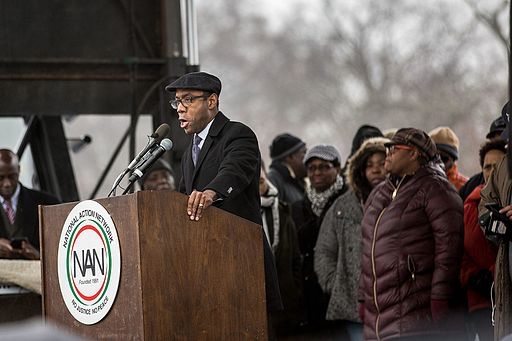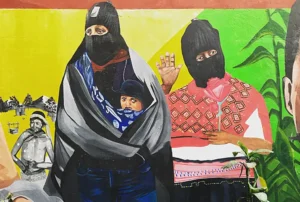
As nonprofits and movements grow and become more complex, identifying what, if any, are the points of intersection is critical. If they don’t meet, the impact ripple is shortened. While larger, more institutional groups appear to feed off the momentum of the smaller, grassroots networks, the smaller, grassroots networks do not appear to be supported by the larger, institutional groups. Connecting across generations on issues of strategy, resources, and leadership can be challenging, but not impossible, and necessary in these times.
It is no secret that there has been some tension between older legacy groups representing the rights and interests of black communities in the United States and the younger, more networked movements represented by Black Lives Matter. That would not be unusual in these times when the dynamics of movements are changing, but can the old simply elect to become new? We will see.
According to Yamiche Alcindor at the New York Times, the national NAACP dismissed its president, Cornell William Brooks, this week after a short three-year tenure as it seeks a “system-wide refresh,” or rebranding. The board of the NAACP “wants a new face…to more effectively push back against Mr. Trump’s stances on issues like voting rights laws, public education, environmental policy and the criminal justice system.”
The vice chairman of the board, Derrick Johnson, said, “We are in a transitional moment. This is the opportune time to begin to look at all our functions as an association and see, are we the right fit for the current reality?” Johnson and the board’s chairman, Leon W. Russell, will lead the day-to-day operations of the organization as it begins its search for a new leader.
Brooks succeeded Benjamin Jealous, who was known for his activism around criminal justice reform in the position but who stayed only six years. Both the NAACP board and Mr. Brooks had said they wanted to work more closely with younger black activists like Black Lives Matter to challenge Trump more vigorously. But, somewhere in there, a gap apparently emerged.
Brooks, according to the Times, is “baffled” by the decision. Under his guidance, he says, the NAACP membership has grown by 87 percent and donations by 200 percent. Brooks recently convened a meeting “to study how the organization could both engage the Trump administration on issues and oppose White House policies that went against the group’s beliefs.”
In fact, Brooks was arrested in January for trying to block the confirmation of the current attorney general, Jeff Sessions, by leading a sit-in in his office.
“To Mr. Brooks, the criticism seemed misplaced. He said he got pushback from some members of the organization’s board for his arrest at Mr. Sessions’ office.
“I’m not ashamed of a mug shot that we earned standing against Senator Sessions and for voting rights,” Mr. Brooks said Friday. “For the NAACP to be the NAACP that history calls us to be, we need to stand at the sides of young people who are standing on the front lines of social justice wherever that happens to be, even if it means in jail.”
And, in a press release coinciding with its dismissal of Mr. Brooks, the NAACP writes,
The NAACP intends to aggressively and nimbly respond to the current climate of political unrest, as well as the assaults upon human and civil rights that threaten our very democracy, as only it can. To do so demands that the Board of the NAACP ensure that organization has the right plan and the right leadership to address these 21st-century challenges.
Sign up for our free newsletters
Subscribe to NPQ's newsletters to have our top stories delivered directly to your inbox.
By signing up, you agree to our privacy policy and terms of use, and to receive messages from NPQ and our partners.
[…]
In their announcement today, the NAACP Board made it clear that everyone will have a place at the table, including its invaluable staff, the new movements for social change, local organizers helping to rebuild our neighborhoods, the faith leaders and other traditional and historic African-Americans organizations that provide much needed services to their communities, social justice advocates tackling income inequality, the millions of marchers who have taken to streets for women rights and immigrant rights, the activists who are fighting for equality for the LGBTQ Americans, business leaders and philanthropists lending private sector support, and the long-time civil rights guardians who have spilled blood so that we can enjoy the freedoms we have today.
Mr. Russell said, about the future of the NAACP,
The group plans to train members on how to disseminate information quickly to counter the White House, how to fight legal battles locally and how to move beyond protesting. Local chapters will also be getting more resources from the national organization to help bolster activism in both urban and rural areas.
But can the NAACP refresh and remake itself enough to retake a central role in movement building? It appears that this younger generation of black activists wants change, but from their perspective, they have not historically seen much from the NAACP. Symone D. Sanders, former national press secretary for Bernie Sanders’ presidential campaign, said, “I don’t think the NAACP is ready for this moment because they have been too risk-averse to engage. If folks aren’t ready to shut it down, to challenge this White House, to challenge Congress, to do more than just march, to do some real direct action, then they will not survive this moment.”
Johnetta Elzie, a Ferguson activist, noted the arrest of Mr. Brooks but said, “I don’t see them as a resource. I don’t ever look in their direction to see what’s going on. I think that’s a problem because their legacy means we should be looking for them for leadership at all times.”
Moe Mitchell, co-founder of and organizer at Blackbird, the rapid respond team of the Movement for Black Lives, had some more pointed observations about the potential relationship between the NAACP and a more networked movement environment:
I think big institutions need to play a different role—provide scaffolding, meeting space, capacity, training, support, etc. for smaller, more nimble actors versus attempting to lane depart and try to do what movements naturally do.
I’m convinced that once organizations or movements mature to a place where they are self-aware and self-interested, they run the risk of betraying their underlying directive to upend societal power dynamics, which is why you always need the countervailing energy of nimble, smaller, less-institutional actors. This sometimes looks like an individual with a Facebook event that goes viral, or a handful of thoughtful radicals with an unlikely target that larger institutions fear challenging due to the risk of losing credibility.
Perhaps the crux of this generational divide can be found in the language used by “institutions” like NAACP and movements like BLM. The NAACP offers many groups “a seat at the table.” But over the last few decades, the table has become a network, and in a network there is no table and no host. In a network, each node has a function and is judged based on how well they perform that function and how well they work with others.
Right now, all hands are needed on deck, but the institutional interests of older organizations can act as powerful barriers unless they are consciously redirected. Without knowing exactly what’s gone on behind the scenes at the NAACP, this internal charge to meet this century and its movements where they’re at may be the right call—but what works in theory is often less than easy in practice.












